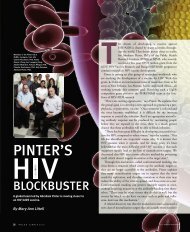changing the course of stroke - New Jersey Medical School ...
changing the course of stroke - New Jersey Medical School ...
changing the course of stroke - New Jersey Medical School ...
Create successful ePaper yourself
Turn your PDF publications into a flip-book with our unique Google optimized e-Paper software.
matrix printers which once produced all <strong>of</strong> our computer printouts,<br />
<strong>the</strong>se auditory nerve pros<strong>the</strong>ses are metamorphosing into<br />
clearer and clearer possible answers for 28 million deaf<br />
Americans. Advances in our understanding <strong>of</strong> <strong>the</strong> central auditory<br />
system in <strong>the</strong> brain, how inner-ear hair cells grow, live and<br />
die, as well as breakthroughs in neuroscience, molecular biology,<br />
biochemistry and even genetics have revolutionized “what is<br />
really a team process,” says Kwartler.<br />
As a medical student at NJMS, Kwartler always knew he<br />
wanted to be a surgeon and found that microsurgical techniques<br />
and miniaturization satisfied <strong>the</strong> technical demands he loved.<br />
After specializing in ear, nose and throat (ENT) medicine, he<br />
went west for a fellowship at <strong>the</strong> House Ear Clinic and Institute<br />
in Los Angeles under <strong>the</strong> legendary Bill House, MD. “I was his<br />
last clinical fellow before his retirement and very fortunate to be<br />
under his tutelage. Cochlear implants were first performed <strong>the</strong>re<br />
in <strong>the</strong> early 1960s and Dr. House, a godfa<strong>the</strong>r <strong>of</strong> this technology,<br />
invented and tried more things than you can imagine.”<br />
Kwartler returned to <strong>New</strong> <strong>Jersey</strong> in 1990. “One <strong>of</strong> <strong>the</strong> reasons<br />
we waited to start this intense program at NJMS is that <strong>the</strong><br />
technology had improved dramatically.” While hearing aids<br />
amplify sound, cochlear implants, even <strong>the</strong> early, simplistic versions,<br />
aimed to compensate for damaged or non-functioning<br />
parts <strong>of</strong> <strong>the</strong> inner ear. Every implant system has an internal<br />
receiver, or surgically implanted element; an externally worn<br />
processor with its battery; and a headpiece with a microphone<br />
and transmitter. The processor, worn ei<strong>the</strong>r behind <strong>the</strong> ear or on<br />
a belt at <strong>the</strong> waist, is a mini-computer that takes sound information,<br />
codes it into electrical signals, transmits <strong>the</strong> signals to<br />
<strong>the</strong> implanted receiver behind <strong>the</strong> ear and <strong>the</strong>n sends <strong>the</strong>m fur<strong>the</strong>r<br />
down to an electrode coiled within <strong>the</strong> cochlea itself.<br />
Most deaf people have lost some or all <strong>of</strong> <strong>the</strong> four parallel<br />
rows <strong>of</strong> cochlear hair cells (so-called because <strong>of</strong> <strong>the</strong> hair-like cilia<br />
on <strong>the</strong>se auditory nerve fibers). Without those 30,000 auditory<br />
nerve fibers to get excited enough to change <strong>the</strong> acoustic energy<br />
<strong>of</strong> sound into electrical energy, <strong>the</strong> brain can’t hear.<br />
“Sound waves are just like ripples on water,” explains<br />
Kwartler. Normally, <strong>the</strong>se pressure waves vibrate down <strong>the</strong> ear<br />
canal, to <strong>the</strong> ear drum with its tympanic membrane, and to <strong>the</strong><br />
three small bones <strong>of</strong> <strong>the</strong> middle ear (malleus, incus and stapes)<br />
which pick up <strong>the</strong> vibrations and pass <strong>the</strong>m on into <strong>the</strong> snail<br />
shaped cochlea <strong>of</strong> <strong>the</strong> inner ear. “The electrode in an implant,<br />
which has been snaked down inside <strong>the</strong> cochlea, is electrically<br />
stimulating <strong>the</strong> surviving nerve fibers,” he explains. Beyond <strong>the</strong><br />
cochlea, research is also investigating <strong>the</strong> role <strong>of</strong> a large bundle<br />
<strong>of</strong> nerve tissue, called <strong>the</strong> efferent system, which takes <strong>the</strong> infor-<br />
28<br />
PULSE SPRING 2003<br />
mation into <strong>the</strong> brain to make real sense <strong>of</strong> <strong>the</strong> sound.<br />
Uncoiled, <strong>the</strong> cochlea would break down into discrete sections<br />
designed to discern various vibrational energies by frequency.<br />
Sound, especially speech, naturally covers a wide<br />
frequency, but <strong>the</strong> early implants had an electrode that delivered<br />
only a single, stimulating current and didn’t target discrete<br />
areas. Thus, <strong>the</strong> implant user would be alerted to some sound<br />
but unable to discriminate speech. “We could show that <strong>the</strong><br />
patient even identified tones at a normal level but couldn’t<br />
understand a single word or sentence,” he explains.<br />
“Technically, <strong>the</strong> operation would be a success but functionally,<br />
<strong>the</strong> computers weren’t powerful enough to code all <strong>the</strong> information<br />
delivered by speech.” What scientists have learned is<br />
that high pitches are picked up near <strong>the</strong> base <strong>of</strong> <strong>the</strong> cochlea<br />
while lower sounds are detected at <strong>the</strong> apex. Meanwhile, different<br />
formulas for trying to determine which was <strong>the</strong> most important<br />
information to deliver to each patient were debated as well<br />
as placement <strong>of</strong> <strong>the</strong> electrode array. The analogy, Kwartler<br />
points out, was like playing Wheel <strong>of</strong> Fortune. (The TV game<br />
show challenges players to guess a word or expression without<br />
seeing every one <strong>of</strong> its letters.) “What ‘letters’ do you need to<br />
know to figure out speech? We couldn’t put all <strong>the</strong> ‘letters’ into<br />
<strong>the</strong> processor but with <strong>the</strong> growth <strong>of</strong> faster and faster, and smaller<br />
and smaller computers, we are able to include more information.<br />
Our understanding <strong>of</strong> what patients need to hear, as well<br />
as what <strong>the</strong>y can live without, has grown as well as <strong>the</strong> speed <strong>of</strong><br />
<strong>the</strong>se processors.”<br />
Produced by two licensed manufacturers in <strong>the</strong> U.S.<br />
(Cochlear Ltd. and Advanced Bionics Corp.), cochlear implant<br />
WHAT CAUSES<br />
HEARING LOSS?<br />
The reason for Dianne Mink’s deafness was never<br />
determined. However, experts do know that <strong>the</strong>re are<br />
two kinds <strong>of</strong> hearing loss: conductive (caused by<br />
middle ear infections, traumatic head injury or birth<br />
defects such as otosclerosis) and sensorineural<br />
(due to heredity, genes, aging, exposure to loud<br />
noise or ototoxic medications.)






